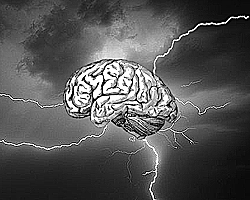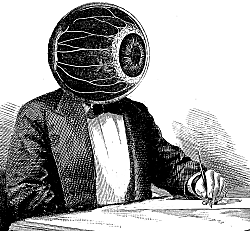 Sue Pockett is back in the JCS with a new paper about her theory that conscious experience is identical with certain electromagnetic patterns generated by the brain. The main aim of the current paper is to offer a new hypothesis about what distinguishes conscious electromagnetic fields from non-conscious ones; basically it’s a certain layered shape, with negative charge on top followed by a positive region, a neutral one, and another positive layer.
Sue Pockett is back in the JCS with a new paper about her theory that conscious experience is identical with certain electromagnetic patterns generated by the brain. The main aim of the current paper is to offer a new hypothesis about what distinguishes conscious electromagnetic fields from non-conscious ones; basically it’s a certain layered shape, with negative charge on top followed by a positive region, a neutral one, and another positive layer.
Pockett sets the scene by suggesting that there are three main contenders when it comes to explaining consciousness: the thesis that consciousness is identical with certain patterns of neuron firing; functionalism, the view that consciousness is a process; and her own electromagnetic field theory. This doesn’t seem a very satisfactory framing. For one thing it doesn’t do much justice to the wild and mixed-up jungle which the field really is (or so it seems to me); second there isn’t really a sharp separation between the first two views she mentions – plenty of people who think consciousness is identical with patterns of neuronal activity would be happy to accept that it’s also a neuronal process. Third, it does rather elevate Pockett herself from the margins to the status of a major contender; forgiveable self-assertion, perhaps, although it may seem a little ungenerous that she doesn’t mention that others have also suggested that consciousness is an electromagnetic field (notably Johnjoe McFadden – although he believes the field is causally effective in brain processes, whereas Pockett, as we shall see, regards it as an epiphenomenon with no significant effects).
Pockett mentions some of the objections to her theory that have come up. One of the more serious ones is the point that the fields she is talking about are in fact tiny and very local: so local that there is no realistic possibility of the field from one neuron influencing the activity of another neuron. Pockett is happy to accept this; conscious experience doesn’t actually have the causal role we usually attribute to it, she says: it’s really just a kind of passenger accompanying mental processes whose course is determined elsewhere. She cites various people in support of this epiphenomenalist view, including Libet – she has some interesting things to say about his experiments (but doesn’t note that he too liked the idea of a mental field of some kind).
The new thesis about the shape of conscious fields appears to spring from observation of neuronal structure in the neocortex, and in particular the fact that in its fourth layer there are no pyramidal cell bodies. This is a feature which appears to be characteristic of the parts of the neocortex often associated with consciousness, and it implies that there is a gap or neutral region in the fields generated there, helping to yield the layered structure mentioned above. Pockett proposes a number of experiments which might support her view, some of which have already been carried out.
So what do we make of that? I see a number of problems.
First is the inherent implausibility of the overall theory. Why on earth would we identify conscious experience with tiny electromagnetic fields? I think the attraction of the theory comes from thinking about two kinds of consciousness, more or less the two kinds identified by Ned Block: the a-consciousness that does the work of useful, practical cogitation, and the p-consciousness which simply endows it with subjective feeling. Looked at from this angle it may be appealing to think that the actual firing of neurons is doing the a-consciousness while the subjectivity, the phenomenal experience, come from the subsidiary electric buzz.
But when we look at it more closely, that doesn’t make any particular sense. The problem is that conscious experience doesn’t seem like anything in physics, whether a field or a lump of matter. If we’re going to identify it with something physical, we might as well identify it with the neurons and simplify our theory – dropping the field entity in obedience to Occam’s Razor. Nothing about the electrical fields helps to explain the nature of phenomenal experience in a way that would motivate us to adopt them.
Second, there’s the problem of Pockett’s epiphenomenalism. Epiphenomenalism is very problematic because if consciousness does not cause any of our actions, our reports and discussions about it cannot have been caused by it either. Pockett’s own account of consciousness could not have been caused by her actual conscious experience, and nothing she writes could be causally related to that actual experience: if she were a zombie with no consciousness, she would have written just the same words. This is a bit of an uncomfortable position in general, but it also means that Pockett’s ambitions to test her theory experimentally are doomed. You cannot test scientifically for the existence of a supposed entity that has no effects because it makes no observable difference whether it’s there or not. All of Pockett’s proposed experiments, on examination, test accessible aspects of her theory to do with how the fields are generated by neurons: none of them test whether consciousness is present or absent, and on her theory no such experiment is possible.
While those issues don’t technically prove that Pockett is wrong, they do seem to me to be bad problems that make her theory pretty unattractive.

